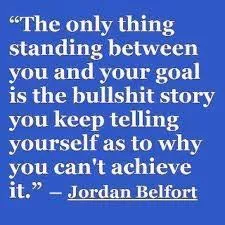Disclaimer: I have affiliate links in this post and receive a commission on any purchases you make at no cost to you. It’s one of the ways I support my site.
Do you know how to set your goals that make you ten times more likely to succeed than not setting them? This fact shows how important it is to set goals right. Yet, only 44% of employees update their goals when their roles change, according to a 2021 survey. This shows we need to learn how to set and keep our goals.
Having clear goals boosts motivation and helps track progress. Edwin Locke’s theory says hard yet reachable goals push us to work harder. But, without a good plan, many people don’t meet their goals. This article will show seven key steps to set and reach your goals.
Understanding the Importance of Goal Setting
Setting goals is key to personal growth. It helps focus and sets a clear path to reach dreams. People grow, feel more confident, and find fulfillment by setting goals. Studies show that having structured goals is vital for success.
Why Goals Matter for Personal Development
Goals are crucial for personal growth. They help people know what they want and why. This leads to self-improvement and a stronger sense of purpose.
Setting goals makes people more resilient. It gives them a reason to keep going, even when things get tough. Following the right steps to set goals can deeply impact personal growth.
Statistics on Goal Achievement
Studies show a strong link between setting goals and reaching them. People aiming for specific goals do better. A survey by Locke and Latham found that most people did better with clear goals than vague ones.
Goals linked to performance, as shown by Elliot and McGregor, lead to better exam scores. This shows that sticking to goals is key to success and personal growth.
Define What You Want to Achieve
Identifying what you want is a key step in making progress. It means thinking about what’s important to you and what success looks like in different areas of life. This clarity helps with planning, letting you focus on goals that match your dreams.
Clarifying Your Desires for Effective Planning
To start a meaningful journey, you need to know what you want. Understanding your goals helps turn vague ideas into clear targets. This gives you direction, as the old Chinese saying goes, “Even the longest journey begins with a single step.” It motivates you to move forward toward your goals.
Aligning Goals with Core Values
Linking goals with values is key to feeling fulfilled. When you know your core values, you can set goals that match them. This makes you more driven to achieve them. Knowing how goals and values connect helps you stay committed to your personal and work goals.

Here’s a table that compares different types of goals, showing their purpose and importance:
| Type of Goal | Description | Purpose |
|---|---|---|
| Short-term Goals | Objectives set to be achieved in the near future | Provides quick wins and motivation |
| Long-term Goals | Objectives set to be achieved soon | Offers a larger vision and direction |
| Personal Goals | Ones focused on self-improvement and well-being | Enhances satisfaction and life quality |
| Professional Goals | Career-related objectives | Drives career growth and development |
| Financial Goals | Targets related to monetary savings or investments | Secures financial stability and freedom |
| Academic Goals | Goals related to education and learning | Encourages continual growth and achievement |
| Social Goals | Objectives focused on building relationships | Enhances social connections and support |
How to Set Your Goals and Stick to It
Setting SMART goals makes it more likely to reach your goals. SMART stands for Specific, Measurable, Attainable, Relevant, and Time-bound. This framework helps turn dreams into real steps. It brings clarity and commitment.
Creating SMART Goals: Specific, Measurable, Attainable, Relevant, Time-bound
Studies show that having a clear plan boosts your chances of sticking to your goals. This is seen in many studies on implementation intentions. These plans detail how and when you’ll achieve your goals.
For example, dieters who planned their eating habits did much better than those without a plan. Clear goals with upper and lower limits help avoid confusion.
The Role of Specificity in Goal Setting
Being specific is key to setting goals well. Vague goals can confuse and lose of focus. Experts suggest focusing on just one main goal to speed up progress and boost success chances.
Using strategies like habit stacking helps keep you on track. When you clearly state your goals, you’re more likely to succeed. For instance, women who planned their self-exams stuck to it every time.
Writing Down Your Goals
Writing down your goals is key to achieving your dreams. It turns vague ideas into clear, achievable goals. By putting your goals in writing, you make a promise to yourself. This makes you more accountable and committed to your plans.
Transforming Vague Ideas into Tangible Objectives
Writing down goals helps clear up your thoughts and makes them doable. Keeping your goals in sight keeps you focused every day. Studies show that writing down goals leads to success and many benefits, like better focus and more motivation.
Here are simple ways to make this work:
- Define specific, measurable outcomes.
- Use detailed descriptions or even pictures to visualize goals.
- Regularly review and revise objectives to maintain clarity.
Using Positive Language for Motivation
Using positive language when setting goals creates a supportive environment for success. Being optimistic helps keep you motivated, even when things get tough. Positive phrases can change your mindset, making you more committed to your goals.
Write with a positive mindset—every time you look at your goals, you’ll feel motivated again. This approach includes:
- Framing setbacks as opportunities for growth.
- Celebrating small victories to build momentum.
- Maintaining a positive narrative around personal development and change.

Statistics show that writing down goals leads to success. This shows how important it is in setting goals. It brings clarity, focus, and motivation, helping you achieve your goals and grow personally.
Creating an Action Plan
Creating a clear action plan is key to making goals happen. It lists the steps needed to reach those goals and provides a clear path to success. Breaking goals into smaller steps makes them feel easier, turning big tasks into doable ones. This method helps people make steady progress, keeping them motivated and on track.
Breaking Goals into Manageable Steps
For success, it’s vital to have action plans with clear steps. Instead of vague goals like “exercising more,” set specific goals like “walking three times a week for 30 minutes each.” Setting deadlines for each task keeps the focus sharp. This approach also helps in prioritizing tasks, especially when tackling multiple goals at once, like cutting down on screen time or adding daily exercise.
Here’s an example of an action plan for starting a personal creative website:
| Task | Deadline | Status |
|---|---|---|
| Research effective website builders | Week 1 | In Progress |
| Create design ideas and layouts | Week 2 | Not Started |
| Purchase domain name | Week 3 | Not Started |
| Build website | Week 4 | Not Started |
| Launch website and promote | Week 5 | Not Started |
Visualizing Your Action Plan for Success
Visualization is a strong tool for making action plans work. Using diagrams, charts, or mind maps can help people stay committed to their goals. Seeing these plans in visual form not only helps in understanding but also keeps motivation high. Regularly checking these visuals can help track progress and celebrate achievements.
Adding creativity to visualizing action plans deepens the connection to goals. This connection helps keep motivation strong and helps overcome obstacles. Staying true to promises made to oneself requires persistence and kindness. Acknowledging both successes and hurdles is crucial for moving forward toward goals.

Creating a Timeline for Your Goals
Creating a timeline is key to reaching your goals. It adds structure and motivation to your planning. Setting deadlines makes you work faster and stay focused. Plus, hitting milestones lets you check progress and celebrate, keeping you motivated.
Setting Deadlines to Foster Urgency
Deadlines keep you moving on your goals. Break big goals into smaller tasks. Giving each task a deadline helps you stay on track and work better.
Setting aside time each week for these tasks helps you stay consistent. Checking how you’re doing helps you fix any problems early.
Key Milestones to Celebrate Progress
Celebrating your wins is like what celebrities do. It gives you a boost and keeps you going. Having a reward system keeps you motivated as you track your progress.
After hitting a milestone, take time to think about your journey. This helps you stay confident and keeps you going long-term.
| Task | Deadline | Milestone | Celebration |
|---|---|---|---|
| Research Goals | Week 1 | Completion of research | Small treat or coffee with a friend |
| Create Action Plan | Week 2 | Action plan finalized | Watch a favorite movie |
| Begin Implementation | Week 3 | Start execution of tasks | Special dinner out |
| Review Progress | Month 1 | Mid-point review | Buy something new for oneself |
| Final Evaluation | Month 3 | Goal achieved | Weekend getaway |
Taking Action Towards Your Goals
Setting goals is just the first step. It’s important to have strategies to keep going and stay motivated. Using motivation techniques helps you move forward, making sure every step helps you reach your goals.
Motivation Techniques to Keep Moving Forward
To stay motivated, try these tips:
- Write down specific, measurable, achievable, relevant, and time-bound goals.
- Read the goals list daily to stay focused and inspired.
- Commit to taking daily action on at least one goal.
- Break down big goals into smaller tasks to feel less overwhelmed.
- Schedule tasks in a calendar to set priorities and manage time well.
- Wake up early to have uninterrupted time for your goals.
Importance of Consistency in Efforts
Being consistent is key to success over time. Regular practice helps you reach your best potential. For example, writing regularly helped an author build a big online following. Doing pushups three times a week also led to big improvements.
Good goal-setting means:
- Setting realistic time for tasks without overdoing it.
- Creating healthy habits that give you the energy to stay focused.
- Being flexible with goals to make changes that help you succeed.
Acting on your goals makes them real. The secret is consistent effort and celebrating your wins to keep going. With time and effort, you’ll see great results.

| Technique | Description | Expected Outcome |
|---|---|---|
| Writing Goals | Detailing goals enhances clarity and focus. | 42% increase in likelihood to achieve. |
| Daily Action | Taking at least one step daily towards a goal. | Maintaining progress and rhythm. |
| Task Breakdown | Dividing goals into bite-sized tasks. | Reduced overwhelm, increased action. |
| Emphasizing Consistency | Regular practice is prioritized over immediate results. | Long-term development and mastery. |
Measuring Your Progress
Measuring progress is key to reaching personal goals. Using tracking techniques helps people stay on track and see their wins. There are many ways to track progress, like using apps or journals. These methods help record and celebrate achievements.
Tracking Techniques for Enhanced Accountability
Strong tracking techniques help keep you accountable. Tools like Microsoft Excel or goal-setting apps make tracking easy. Writing down goals boosts motivation and helps you see your progress. Working with others or joining groups can also provide support and celebrate your successes.
Adjusting Goals Based on Progress Reviews
Adjusting goals is important for staying focused. Regular reviews help spot strengths and areas to improve. Using Pareto’s principle can guide you to focus on what matters most. Cutting less important goals and focusing on one main goal at a time speeds up progress. This keeps your efforts in line with your goals.

Staying Committed to Goals
Being committed to goals is key to success. By using the heart, capabilities, and instincts, people can match their goals with what they truly want and can do. It’s important to be excited and put effort into your goals. This part talks about how making habits and having support helps keep you committed.
Building Habits that Stick for Long-term Success
Creating lasting habits is vital for long-term success. It’s important to pick goals that touch your heart, making you more emotionally invested. Having the right knowledge, skills, and experience also helps keep you committed. Choosing goals that you enjoy makes you more eager and persistent.
- Assess past goals to identify missing commitment factors.
- Set exciting short-term goals to boost motivation and progress.
- Celebrate small wins regularly to sustain excitement and confidence.
The Role of Environment and Support Systems
Having a strong network helps achieve goals. Being around supportive people and having accountability partners makes you more committed. For entrepreneurs, knowing who you’re serving and how you impact them helps clarify your path. Using tools like Kolbe can help understand your instincts, making you more committed to your goals.
Having systems for accountability, like a coach or peer group, keeps you focused and moving forward. Tracking your progress regularly keeps you motivated and confident. When planning, focus on activities that match your main goals, helping you stay committed on your journey.
Overcoming Common Obstacles in Goal Achievement
Reaching goals can feel overwhelming with many challenges. It’s key to spot the barriers to success to move forward. Many face issues like putting things off, unclear goals, or life changes that throw off their plans. Knowing these obstacles helps us tackle them effectively.
Identifying Barriers to Success
Common barriers to success include:
- Low motivation and laziness
- Fear of failure and change
- Time management issues
- Negative self-talk
- Lack of prioritization

Statistics show that 85% of those who wait until ‘someday’ often miss their goals. This highlights the importance of tackling these problems early.
Also, 60% of people who don’t plan for challenges might find it hard, showing the need for realistic goal setting.
Strategies for Maintaining Motivation
Here are some ways to stay motivated:
- Write down specific goals to make them clear.
- Plan to do something, like meditating for 15 minutes each day.
- Set short goals to help you reach your big ones.
Having a clear plan and staying focused helps you get past obstacles. Getting support from friends or experts can also boost your motivation. Remember, 75% of those who see mistakes as bad might give up, so staying positive is key to success.
| Barrier to Success | Impact on Goal Achievement | Recommended Strategy |
|---|---|---|
| Procrastination | Delays progress and reduces likelihood of success | Establish deadlines for actions |
| Lack of Clarity | Leads to vague goals | Define specific outcomes you want to achieve |
| Fear of Failure | Prevents risk-taking and action | Reframe mistakes as learning opportunities |
| Negative Self-Talk | Decreases confidence and motivation | Practice positive affirmations and self-compassion |
| Lack of Prioritization | Causes important tasks to be neglected | List and rank goals by importance |
Conclusion
Achieving personal and professional goals is a journey that needs clarity, planning, action, evaluation, and adaptation. It starts with setting clear goals that match your values. This helps you live a more meaningful life.
Without short-term goals, seeing success is hard. This can make you feel restless or without direction. Setting long-term goals helps you avoid just meeting basic needs. It helps you dream of a bright future.
Regularly reflecting and planning keeps you committed to your goals. This keeps your vision clear of what you want to achieve. It boosts your motivation and helps you bounce back from challenges.
Being flexible and adaptable when setting goals is key to success and growth. By making goals you can achieve and thinking about what motivated you before, you move forward in learning and getting better.
Effective goal-setting balances today’s actions with future dreams. Celebrating your progress and staying committed builds habits that lead to success and better well-being. The journey requires hope and an open mind. True success comes from hard work and a positive attitude.
Frequently Asked Questions
Q: How can I start setting goals effectively?
A: To start setting goals effectively, begin by identifying your core objectives and breaking them down into smaller, manageable tasks. Write your goals clearly and ensure they are specific and time-bound. Using a SMART goal-setting template can be very helpful in this process.
Q: What can I do to stick to my goals?
A: To stick to your goals, it’s important to create a specific plan and align your environment to support your objectives. Regularly review your progress and adjust your strategies as needed. Holding yourself accountable, either through self-monitoring or involving a life coach, can also help you stay on track.
Q: How can setting a goal improve my life?
A: Setting a goal provides direction and purpose, helping you make informed decisions and plan for the future. Goals can sometimes be challenging, but they are essential for personal growth and self-improvement. By working toward your goals, you are likely to actually make progress and achieve success.
Q: What steps should I take to get started on actually making progress?
A: First, write your goals and break them down into actionable tasks. Next, create a timeline with deadlines for each task to ensure consistent progress. Make plans to regularly review your progress and adjust your approach if necessary. Finally, maintain motivation by celebrating small victories along the way.
Q: How do I stay motivated in working toward my goals?
A: Staying motivated involves regularly reminding yourself of the reasons why you set the goals in the first place. Visualize the outcomes and benefits of achieving your goals. Surround yourself with supportive people and resources that enhance your motivation and align your environment to minimize distractions.
Q: What can I do to follow through with my goals consistently?
A: Consistently following through with your goals requires discipline and a strong commitment. Set regular check-ins to review your progress and make adjustments as needed. It can be helpful to use tools such as calendars, to-do lists, or a goal-setting template to stay organized and focused.
Q: Why is it important to have a real and tangible plan for your goals?
A: Having a real and tangible plan for your goals provides a clear roadmap to success, making it easier to track and measure progress. This level of organization increases the likelihood that you will stick to their goals and achieve them, as opposed to having vague or undefined objectives.
Q: How can I align my environment to support my goals?
A: Aligning your environment involves arranging your physical and social surroundings to support your objectives. This can mean creating a workspace free of distractions, associating with people who encourage your endeavors, and eliminating factors that may hinder your progress. Making such adjustments can greatly enhance your ability to stay focused and motivated.
Q: What are some common challenges in sticking to goals, and how can they be overcome?
A: Common challenges include lack of motivation, time management issues, and unexpected obstacles. These can be overcome by setting realistic and achievable goals, regularly reviewing and adjusting plans, seeking support from others, and maintaining a positive mindset. By anticipating potential obstacles and having strategies in place to address them, you are more likely to stick to your goals.
Q: Can having a life coach help you set and stick to your goals?
A: Yes, having a life coach can provide valuable guidance in setting and sticking to goals. A life coach can help you clarify your objectives, develop a specific plan, and provide ongoing support and accountability. With their assistance, you are more likely to actually follow through with your goals and achieve the results you desire.








